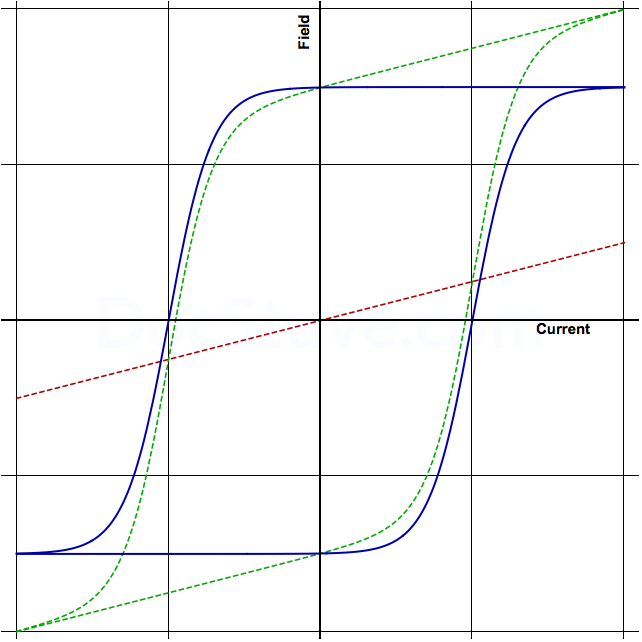Magnet Materials and BH Curves
Magnet materials have two important properties.
- The magnetic strength of the material.
- The resistance to demagnetization of the material.
BH curves show how these properties are related.
What is a BH Curve?
The best way to understand BH curves is to start with a simple experiment. What happens when a coil is used to magnetize a magnet?
A Coil magnetizing a magnet
The top two graphs show what happens when current passes through an empty coil. A strong field is formed at the center of the coil. If the current is reversed, the field is reversed. The origin at the center is where the current and field are both zero.
The red line on the plot shows the field strength for an applied current. As the current increases, the field increases. If the current reverses, the field reverses.
The bottom graph shows the same coil with magnetic material inside. The block of material is magnetized and demagnetized by the coil's field.
The green curve shows the total field inside the coil. The total field is a combination of the coil field and the material field. Notice the hysteresis. This is because the material stays magnetized or demagnetized until the coil field is strong enough to change it.
The field from the magnetic material
We want to know what the field is due to the magnetic material. In the above graphs, we have the coil field (in red) and the total field (green).
If we subtract the coil field from the total field, we are left with the field from the material. This is shown in blue.
As it turns out, if we look at only the upper left quadrant, we are left with BH curves.
In practice, the testing apparatus is often more complicated than a single coil, specific shapes of material are used, and the horizontal axis is plotted as the coil field rather than current. However, the idea is the same. Our simplified experiment uses the same concepts.
Note that these curves are schematics. They are not simulation results nor experimental data. Actual BH curves for real materials are not as straight and smooth as shown here.
Example of Intrinsic BH Curve
This is an example of what a BH curve looks like. It is a schematic and is not based on experimental data. The two axes are traditionally labeled B and H.
- B can be thought of as how much the material is magnetized.
- H can be thought of as the demagnetizing field. As a matter of convention, these H values are listed as positive. As the demagnetizing field increases, the internal material field drops.
There are three important positions on this curve.
- The top point (labeled Br) can be thought of as the natural magnet strength. It is the material field strength when the coil field is zero. After the coil has gone to full strength and back to zero, this is how much the material remains magnetized. The technical term used is remanence.
- The lower point (labeled Hci) can be thought of as how much field must be applied to completely demagnetize the material. It is where the material is completely demagnetized. The technical term used is coercivity.
- There is also the place where the curve starts to drop quickly. This is referred to as the "knee" of the curve. Ideally, in any application the magnet will have small enough demagnetizing fields so that the material stays in the upper flat portion of the curve.
Typical BH Curves for Common Material families
There are three common families of magnet materials. The curves shown here are typical. Actual specific materials can vary from this. Also, the BH curve for specific materials varies with temperature.
Rare-earth materials have good strength and good resistance to demagnetization. They are the most expensive.
Ferrite (or ceramic) materials are weaker and have reasonable resistance to demagnetization. They are the cheapest.
Alnico materials have good strength but are very easy to demagnetize.
For most sensing applications, rare-earth and ferrite materials are in common use.




